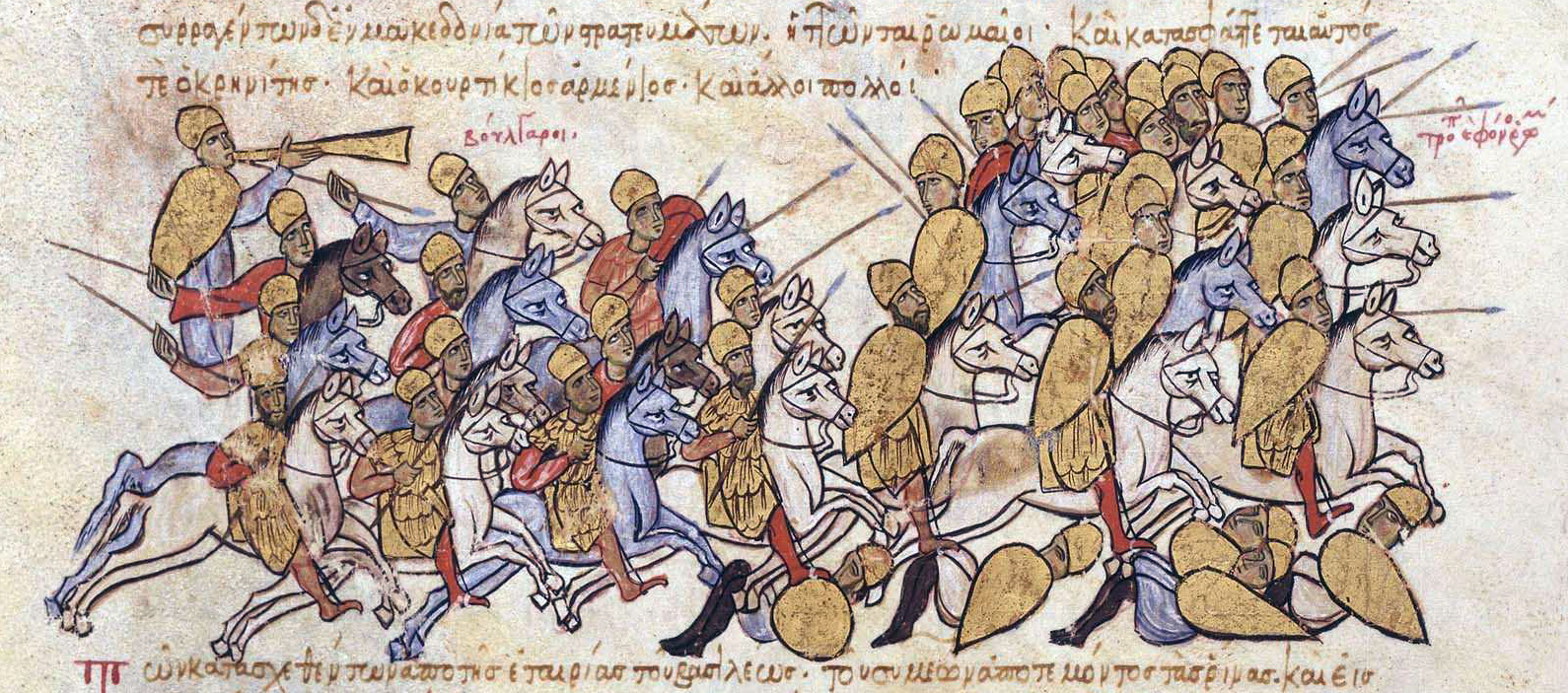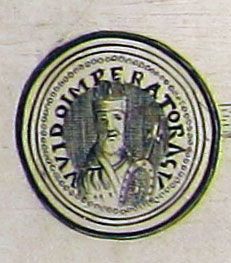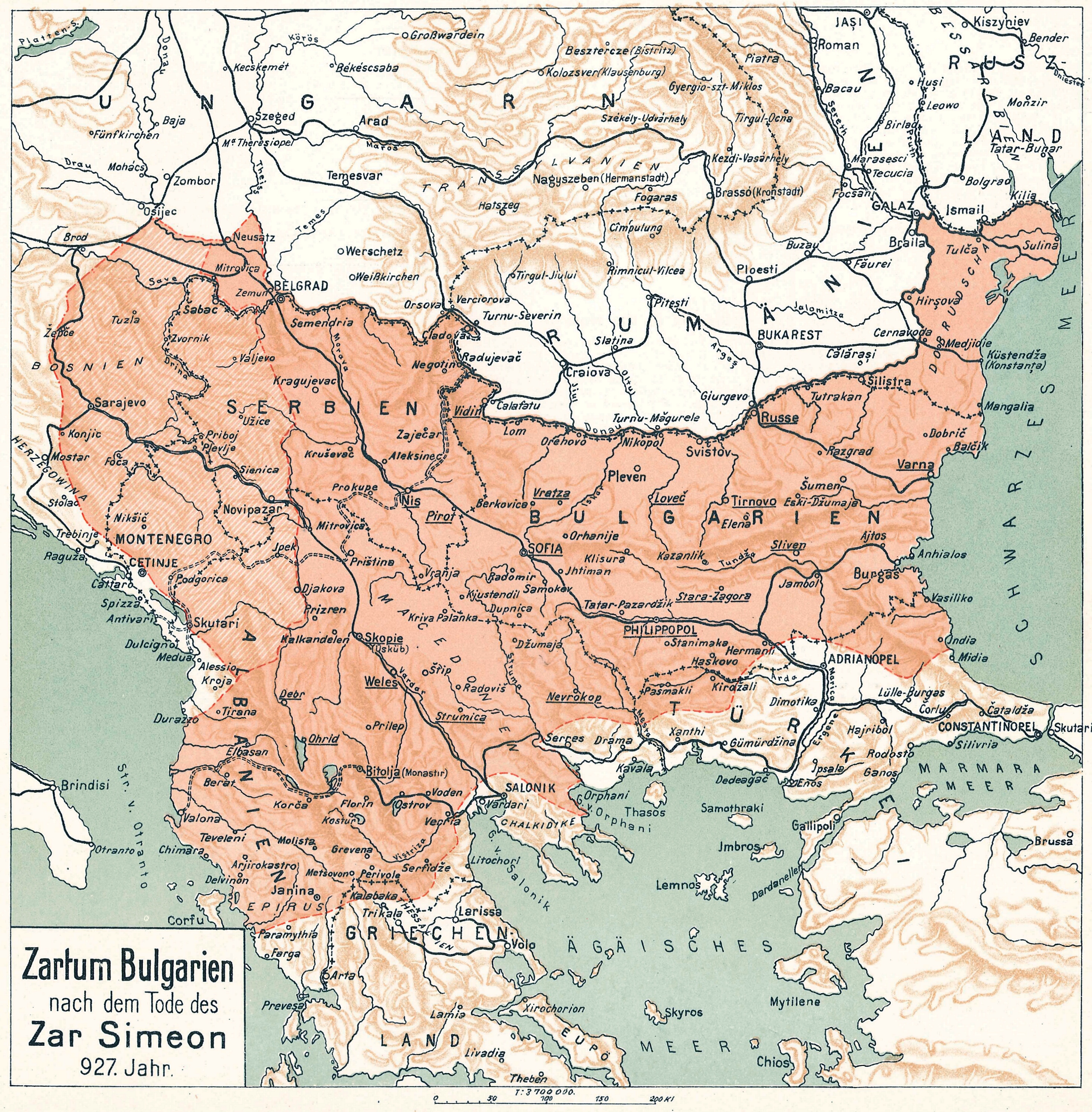|
894
__NOTOC__ Year 894 ( DCCCXCIV) was a common year starting on Tuesday of the Julian calendar. Events By place Byzantine Empire * Byzantine–Bulgarian War: Stylianos Zaoutzes, leading minister and '' basileopator'', convinces Emperor Leo VI (the Wise) to move the Bulgarian market from Constantinople to Thessaloniki. This affects the commercial importance of Bulgarian trade. Simeon I, ruler ('' khan'') of the Bulgarian Empire, mobilizes his Bulgarian forces and invades Byzantine territory, ravaging the countryside. Europe * Spring – King Arnulf of Carinthia invades Italy at the head of an East Frankish expeditionary army, joining up with the deposed king Berengar I at Verona. He conquers Brescia after little resistance, and sacks Bergamo after a one-month siege. The cities of Milan and Pavia open their doors to Arnulf. Emperor Guy III escapes from Pavia, to hide in the mountains of Spoleto (Umbria). * March – Arnulf of Carinthia proceeds to Piacenza, a ... [...More Info...] [...Related Items...] OR: [Wikipedia] [Google] [Baidu] |
Guy III Of Spoleto
Guy III of Spoleto (, ; died 12 December 894) was the Margrave of Camerino from 880, and became Duke of Spoleto and Camerino in 883. He was crowned King of Italy in 889 and emperor by the pope in 891. Guy died in 894 while campaigning to assert control over the Italian Peninsula. Guy was married to Ageltrude, daughter of Adelchis of Benevento, who had a son with him named Lambert. Early life Guy was the second son of Guy I of Spoleto and Itta, daughter of Sico of Benevento. Guy I was the son of Lambert I of Nantes and his second wife, Adelaide of Lombardy, who was a daughter of Charlemagne's second eldest son, Pepin of Italy. In 842, the former Duchy of Spoleto, which had been donated to the Papacy by Charlemagne, was resurrected by the Franks to be held against Byzantine catapans to the south, as a Frankish border territory by a dependent margrave. Consequently, Guy’s family had been important players in Italian politics since the early ninth century. Although in ... [...More Info...] [...Related Items...] OR: [Wikipedia] [Google] [Baidu] |
Byzantine–Bulgarian War Of 894–896
The Byzantine–Bulgarian war of 894–896 () was fought between the Bulgarian Empire and the Byzantine Empire as a result of the decision of the Byzantine emperor Leo VI to move the Bulgarian market from Constantinople to Thessalonica which would greatly increase the expenses of the Bulgarian merchants. Following the defeat of the Byzantine army in the initial stages of the war in 894 Leo VI sought aid from the Magyars who at the time inhabited the steppes to the north-east of Bulgaria. Aided by the Byzantine navy, in 895 the Magyars invaded Dobruja and defeated the Bulgarian troops. Simeon I called for truce and deliberately protracted the negotiations with the Byzantines until securing the assistance of the Pechenegs. Cornered between the Bulgarians and the Pechanegs, the Magyars suffered a crushing defeat at the hands of the Bulgarian army and had to migrate westwards, settling in Pannonia. With the Magyar threat eliminated, Simeon led his hosts south and routed the By ... [...More Info...] [...Related Items...] OR: [Wikipedia] [Google] [Baidu] |
Arnulf Of Carinthia
Arnulf of Carinthia ( – 8 December 899) was the duke of Carinthia who overthrew his uncle Emperor Charles the Fat to become the Carolingian king of East Francia from 887, the disputed king of Italy from 894, and the disputed Holy Roman Emperor, emperor from 22 February 896 until his death at Ratisbon, Duchy of Bavaria, Bavaria. Early life Illegitimacy and early life Arnulf was the illegitimate son of Carloman of Bavaria and Liutswind, who may have been the sister of Ernst, Count of the Bavarian Margraviate of the Nordgau, Nordgau Margraviate (now in the area of the Upper Palatinate), or perhaps the burgrave of Passau, according to other sources. After Arnulf's birth, Carloman married before 861, a daughter of that same Count Ernst, who died after 8 August 879. As it is mainly West Francia, West-Franconian historiography that speaks of Arnulf's illegitimacy, it is quite possible that the two women are actually the same person, Liutswind, and that Carloman married Arnulf's mothe ... [...More Info...] [...Related Items...] OR: [Wikipedia] [Google] [Baidu] |
First Bulgarian Empire
The First Bulgarian Empire (; was a medieval state that existed in Southeastern Europe between the 7th and 11th centuries AD. It was founded in 680–681 after part of the Bulgars, led by Asparuh of Bulgaria, Asparuh, moved south to the northeastern Balkans. There they secured Byzantine Empire, Byzantine recognition of their right to settle south of the Danube by Battle of Ongal, defeatingpossibly with the help of Seven Slavic tribes, local South Slavic tribesthe Byzantine army led by Constantine IV. During the 9th and 10th century, Bulgaria at the height of its power spread from the Danube Bend to the Black Sea and from the Dnieper River to the Adriatic Sea and became an important power in the region competing with the Byzantine Empire. As the state solidified its position in the Balkans, it entered into a centuries-long interaction, sometimes friendly and sometimes hostile, with the Byzantine Empire. Bulgaria emerged as Byzantium's chief antagonist to its north, resulting in ... [...More Info...] [...Related Items...] OR: [Wikipedia] [Google] [Baidu] |
Simeon I Of Bulgaria
Simeon I the Great (; ; ) ruled over Bulgaria from 893 to 927,Lalkov, ''Rulers of Bulgaria'', pp. 23–25. during the First Bulgarian Empire. Simeon's successful campaigns against the Byzantines, Magyars and Serbs led Bulgaria to its greatest territorial expansion ever, making it the most powerful state in contemporary Eastern and Southeast Europe. His reign was also a period of unmatched cultural prosperity and enlightenment later deemed the Golden Age of Bulgarian culture. During Simeon's rule, Bulgaria spread over a territory between the Aegean, the Adriatic and the Black seas.Bakalov, ''Istorija na Bǎlgarija'', "Simeon I Veliki". The newly independent Bulgarian Orthodox Church became the first new patriarchate besides the Pentarchy, and Bulgarian Glagolitic and Cyrillic translations of Christian texts spread all over the Slavic world of the time. It was at the Preslav Literary School in the 890s that the Cyrillic alphabet was developed. [...More Info...] [...Related Items...] OR: [Wikipedia] [Google] [Baidu] |
Berengar I Of Italy
Berengar I (; ; 845 – 7 April 924) was the king of Italy from 887 and Holy Roman Emperor, emperor between 915 and his death in 924. He is usually known as Berengar of Friuli, since he ruled the March of Friuli from 874 until at least 890, but he had lost control of the region by 896. Berengar rose to become one of the most influential laymen in the empire of Charles the Fat, and he was elected to replace Charles in Italy after the latter's deposition in November 887. His long reign of 36 years saw him opposed by no fewer than seven other claimants to the Italian throne. His reign is usually characterised as ''troubled'' because of the many competitors for the crown and because of the Hungarian invasions of Europe, arrival of Magyar raiders in Western Europe. His death was followed by an imperial interregnum that lasted 38 years until Otto I was crowned emperor in 962. Margrave of Friuli, 874–887 His family was called the Unruochings after his grandfather, Unruoch II of Fri ... [...More Info...] [...Related Items...] OR: [Wikipedia] [Google] [Baidu] |
Pavia
Pavia ( , ; ; ; ; ) is a town and comune of south-western Lombardy, in Northern Italy, south of Milan on the lower Ticino (river), Ticino near its confluence with the Po (river), Po. It has a population of c. 73,086. The city was a major political centre in the medieval period, being the capital of the Ostrogothic Kingdom from 540 to 553, of the Kingdom of the Lombards from 572 to 774, of the Kingdom of Italy (Holy Roman Empire), Kingdom of Italy from 774 to 1024 and seat of the Visconti of Milan, Visconti court from 1365 to 1413. Pavia is the capital of the fertile province of Pavia, which is known for a variety of agricultural products, including wine, rice, cereals, and dairy products. Although there are a number of industries located in the suburbs, these tend not to disturb the peaceful atmosphere of the town. It is home to the ancient University of Pavia (founded in 1361 and recognized in 2022 by the Times Higher Education World University Rankings, Times Higher Education ... [...More Info...] [...Related Items...] OR: [Wikipedia] [Google] [Baidu] |
Leo VI The Wise
Leo VI, also known as Leo the Wise (; 19 September 866 – 11 May 912), was Byzantine Emperor from 886 to 912. The second ruler of the Macedonian dynasty (although his parentage is unclear), he was very well read, leading to his epithet. During his reign, the renaissance of letters, begun by his predecessor Basil I, continued; but the Byzantine Empire, empire also saw several military defeats in the Balkans against First Bulgarian Empire, Bulgaria and against the Arabs in Sicily and the Aegean Sea, Aegean. His reign also witnessed the formal discontinuation of several ancient Roman institutions, such as the separate office of Roman consul. Early life Born on 19 September 866 to the empress Eudokia Ingerina, Leo was either the illegitimate son of Emperor Michael III or the second son of Michael's successor, Basil I the Macedonia (theme), Macedonian. Eudokia was both Michael III's Mistress (lover), mistress and Basil's wife. In 867, Michael was assassinated by Basil, who succeeded ... [...More Info...] [...Related Items...] OR: [Wikipedia] [Google] [Baidu] |
Thessaloniki
Thessaloniki (; ), also known as Thessalonica (), Saloniki, Salonika, or Salonica (), is the second-largest city in Greece (with slightly over one million inhabitants in its Thessaloniki metropolitan area, metropolitan area) and the capital city, capital of the geographic regions of Greece, geographic region of Macedonia (Greece), Macedonia, the administrative regions of Greece, administrative region of Central Macedonia and the Decentralized Administration of Macedonia and Thrace. It is also known in Greek as , literally "the co-capital", a reference to its historical status as the "co-reigning" city () of the Byzantine Empire alongside Constantinople. Thessaloniki is located on the Thermaic Gulf, at the northwest corner of the Aegean Sea. It is bounded on the west by the Axios Delta National Park, delta of the Axios. The Thessaloniki (municipality), municipality of Thessaloniki, the historical centre, had a population of 319,045 in 2021, while the Thessaloniki metropolitan are ... [...More Info...] [...Related Items...] OR: [Wikipedia] [Google] [Baidu] |
Milan
Milan ( , , ; ) is a city in northern Italy, regional capital of Lombardy, the largest city in Italy by urban area and the List of cities in Italy, second-most-populous city proper in Italy after Rome. The city proper has a population of nearly 1.4 million, while its Metropolitan City of Milan, metropolitan city has 3.2 million residents. Within Europe, Milan is the fourth-most-populous List of urban areas in the European Union, urban area of the EU with 6.17 million inhabitants. According to national sources, the population within the wider Milan metropolitan area (also known as Greater Milan) is estimated between 7.5 million and 8.2 million, making it by far the List of metropolitan areas of Italy, largest metropolitan area in Italy and List of metropolitan areas in Europe, one of the largest in the EU.* * * * Milan is the economic capital of Italy, one of the economic capitals of Europe and a global centre for business, fashion and finance. Milan is reco ... [...More Info...] [...Related Items...] OR: [Wikipedia] [Google] [Baidu] |
Stylianos Zaoutzes
Stylianos Zaoutzes () was a high Byzantine official of Armenian origin. Rising to high rank under Byzantine emperor Basil I (reigned 867–886), he then rose further to prominence under Basil's successor Emperor Leo VI the Wise (r. 886–912), who had a close friendship and possibly an affair with Stylianos's daughter Zoe Zaoutzaina. Stylianos Zaoutzes was Leo's leading minister during the first half of his reign, and was awarded the unique title of '' basileopator''. His standing and influence declined after 895, but in 898, he became Leo's father-in-law when the Byzantine emperor married Zoe. He died in 899, in the same year as Zoe. Following an attempted coup by his relatives, the Zaoutzes clan was deprived of the considerable power it had amassed under Stylianos's tutelage. Biography Origins and early career Zaoutzes was of Armenian descent, and was born in the '' thema'' of Macedonia. It has been theorized by the historian Nicholas Adontz that Zaoutzes might be the son of a ... [...More Info...] [...Related Items...] OR: [Wikipedia] [Google] [Baidu] |
Rudolph I Of Burgundy
Rudolph I ( – 25 October 912) was King of Upper Burgundy from his election in 888 until his death. A member of the elder Welf family, Rudolph was the son of Conrad, Count of Auxerre and Waldrada of Worms. From his father he inherited the lay abbacy of Saint-Maurice d'Agaune, making him the most powerful magnate in Upper Burgundy - present-day Western Switzerland and Franche-Comté. After the deposition and death of Charles the Fat in 888,{{sfn, MacLean, 2003, p= the nobles and leading clergy of Upper Burgundy met at Saint-Maurice and elected Rudolph as king.{{sfn, Riché, 1993, p=221{{sfn, Hauff, 2018, p=1–13 Apparently on the basis of this election, Rudolph claimed the whole of Lotharingia, taking much of modern Lorraine and Alsace - but his claim was contested by Arnulf of Carinthia, the new king of East Francia, who rapidly forced Rudolph to abandon Lotharingia in return for recognition as king of Upper Burgundy. However, hostilities between Rudolph and Arnulf ... [...More Info...] [...Related Items...] OR: [Wikipedia] [Google] [Baidu] |









